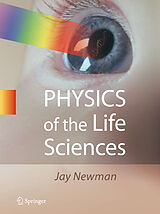Physics of the Life Sciences
Einband:
Fester Einband
EAN:
9780387772585
Untertitel:
Englisch
Autor:
Jay Newman
Herausgeber:
Springer New York
Auflage:
2008
Anzahl Seiten:
740
Erscheinungsdatum:
09.10.2008
ISBN:
0387772588
In both experimental techniques and basic understanding of process and function, physics is integral to most areas of modern life science. This text, filled with beautiful photographs and illustrations, explores those connections of fundamental physics to biology, biophysics and medicine.
Course-tested text directed specifically at the needs of Life and Health Science and Pre-medical students Fully integrates biology, biophysics and medical techniques into the presentation of modern physics Profusely illustrated with many color photos and line drawings Chapters contain three types of learning aids for the student: open-ended questions, multiple-choice questions, and quantitative problems in addition to numerous worked examples Solutions manual available for instructors
Autorentext
Physics for Life Sciences has its origins in a course that the author began developing at Union College in the mid 80s to teach physics to life science students in a way that would interest them and show the connections of fundamental physics to modern biology and medicine. This book is directed at life science students, and integrates modern biology, biophysics and medical techniques into the presentation of the material.
An exception to this is the presentation of one-dimensional mechanics through forces and energy before introducing vectors and generalizing to motion in more than one dimension. This allows students to focus on the physics concepts of kinematics, forces and energy without being distracted by the ideas of vector analysis. Also, an introductory chapter on the stability and structure of matter lays out basic concepts on atoms, forces in nature and energy in some detail so that these can be referred to on a conceptual basis from the start.
Wherever possible, themes from biology or medicine are used to present the physics material. The material speaks to life science students. Rather than optional sections at the end of occasional chapters, life science themes are plentiful and integral to the material in many places. Some of these topics are to be found as optional sections in other texts, but their role here is more fundamental.
The author has also chosen to not use any calculus in the main body of the text. There is occasional boxed material (averaging less than one box per chapter) using some calculus to derive fundamental relations. There is no other use of calculus in the text or in any of the end of chapter problems and the boxed material can be ignored without any loss of continuity.
Each chapter has three types of learning aides for the student: open-ended questions, multiple-choice questions, and quantitative problems. There is an average of about 50 per chapter. There are also a number of worked examples in the chapters, averaging over 5 per chapter, and almost 600 photos and line drawings.
Klappentext
Originally developed for the author's course at Union College, this text is designed for life science students who need to understand the connections of fundamental physics to modern biology and medicine. Almost all areas of modern life sciences integrally involve physics in both experimental techniques and in basic understanding of structure and function. Physics of the Life Sciences is not a watered-down, algebra-based engineering physics book with sections on relevant biomedical topics added as an afterthought. This authoritative and engaging text, which is designed to be covered in a two-semester course, was written with a thoroughgoing commitment to the needs and interests of life science students. Although covering most of the standard topics in introductory physics in a more or less traditional sequence, the author gives added weight and space to concepts and applications of greater relevance to the life sciences. Students benefit from occasional sidebars using calculus to derive fundamental relations, but only algebra and trigonometry are used to explore the basic physical concepts in the main body of the text and to solve end-of-chapter problems.
Inhalt
Newton#x2019;s Laws of Motion for a Particle Moving in One Dimension.- Applications of Newton#x2019;s Laws of Motion in One Dimension.- Work and Energy in One Dimension.- Motion, Forces, and Energy in More Than One Dimension.- Momentum.- Rotational Motion.- Ideal Fluids.- Viscous Fluids.- Waves and Resonance.- Sound.- Thermal Energy.- Thermodynamics: Beyond the First Law.- Electric Forces and Fields.- Electric Energy and Potential.- Electric Current and Cell Membranes.- Magnetic Fields.- Electromagnetic Induction and Radiation.- Electromagnetic Waves.- Geometrical Optics.- Optical Lenses and Devices.- Wave Optics.- Imaging Using Wave Optics.- Special Relativity and Quantum Physics.- The Structure of Matter.- Nuclear Physics and Medical Applications.

Leider konnten wir für diesen Artikel keine Preise ermitteln ...
billigbuch.ch sucht jetzt für Sie die besten Angebote ...
Die aktuellen Verkaufspreise von 6 Onlineshops werden in Realtime abgefragt.
Sie können das gewünschte Produkt anschliessend direkt beim Anbieter Ihrer Wahl bestellen.
Loading...
Die aktuellen Verkaufspreise von 6 Onlineshops werden in Realtime abgefragt.
Sie können das gewünschte Produkt anschliessend direkt beim Anbieter Ihrer Wahl bestellen.
| # | Onlineshop | Preis CHF | Versand CHF | Total CHF | ||
|---|---|---|---|---|---|---|
| 1 | Seller | 0.00 | 0.00 | 0.00 |
